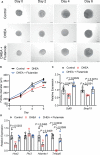Effects of Androgen Excess-Related Metabolic Disturbances on Granulosa Cell Function and Follicular Development
- PMID: 35237237
- PMCID: PMC8883052
- DOI: 10.3389/fendo.2022.815968
Effects of Androgen Excess-Related Metabolic Disturbances on Granulosa Cell Function and Follicular Development
Abstract
Polycystic ovary syndrome (PCOS) is a common reproductive endocrine disease in women of reproductive age. Ovarian dysfunction including abnormal steroid hormone synthesis and follicular arrest play a vital role in PCOS pathogenesis. Hyperandrogenemia is one of the important characteristics of PCOS. However, the mechanism of regulation and interaction between hyperandrogenism and ovulation abnormalities are not clear. To investigate androgen-related metabolic state in granulosa cells of PCOS patients, we identified the transcriptome characteristics of PCOS granulosa cells by RNA-seq. Gene ontology (GO) and Kyoto Encyclopedia of Genes and Genomes (KEGG) analysis of differentially expressed genes (DEGs) revealed that genes enriched in lipid metabolism pathway, fatty acid biosynthetic process and ovarian steroidogenesis pathway were abnormally expressed in PCOS granulosa cells in comparison with that in control. There are close interactions among these three pathways as identified by analysis of the protein-protein interaction (PPI) network of DEGs. Furthermore, in vitro mouse follicle culture system was established to explore the effect of high androgen and its related metabolic dysfunction on follicular growth and ovulation. RT-qPCR results showed that follicles cultured with dehydroepiandrosterone (DHEA) exhibited decreased expression levels of cumulus expansion-related genes (Has2, Ptx3, Tnfaip6 and Adamts1) and oocyte maturation-related genes (Gdf9 and Bmp15), which may be caused by impaired steroid hormone synthesis and lipid metabolism, thus inhibited follicular development and ovulation. Furthermore, the inhibition effect of DHEA on follicle development and ovulation was ameliorated by flutamide, an androgen receptor (AR) antagonist, suggesting the involvement of AR signaling. In summary, our study offers new insights into understanding the role of androgen excess induced granulosa cell metabolic disorder in ovarian dysfunction of PCOS patients.
Keywords: follicular development; in vitro follicle culture; metabolic disorders; ovarian dysfunction; polycystic ovary syndrome.
Copyright © 2022 Liao, Qi, Yun, Qiao and Pang.
Conflict of interest statement
The authors declare that the research was conducted in the absence of any commercial or financial relationships that could be construed as a potential conflict of interest.
Figures






Similar articles
-
Modulation of steroidogenesis by vitamin D3 in granulosa cells of the mouse model of polycystic ovarian syndrome.Syst Biol Reprod Med. 2017 Jun;63(3):150-161. doi: 10.1080/19396368.2017.1296046. Epub 2017 Mar 27. Syst Biol Reprod Med. 2017. PMID: 28345956
-
Erchen Decoction ameliorates the rat model of polycystic ovary syndrome by regulating the steroid biosynthesis pathway.Phytomedicine. 2025 Jul 25;143:156852. doi: 10.1016/j.phymed.2025.156852. Epub 2025 May 20. Phytomedicine. 2025. PMID: 40446578
-
Liraglutide improves follicle development in polycystic ovary syndrome by inhibiting CXCL10 secretion.Reprod Biol Endocrinol. 2024 Aug 6;22(1):98. doi: 10.1186/s12958-024-01269-9. Reprod Biol Endocrinol. 2024. PMID: 39107809 Free PMC article.
-
Autophagy in ovary and polycystic ovary syndrome: role, dispute and future perspective.Autophagy. 2021 Oct;17(10):2706-2733. doi: 10.1080/15548627.2021.1938914. Epub 2021 Jun 23. Autophagy. 2021. PMID: 34161185 Free PMC article. Review.
-
Interactions between androgens, FSH, anti-Müllerian hormone and estradiol during folliculogenesis in the human normal and polycystic ovary.Hum Reprod Update. 2016 Nov;22(6):709-724. doi: 10.1093/humupd/dmw027. Epub 2016 Aug 27. Hum Reprod Update. 2016. PMID: 27566840 Review.
Cited by
-
Integrated single-cell and spatial transcriptomics reveal microenvironment disruptions by androgen in mouse ovary.iScience. 2024 Sep 24;27(10):111028. doi: 10.1016/j.isci.2024.111028. eCollection 2024 Oct 18. iScience. 2024. PMID: 39429789 Free PMC article.
-
Free Androgen Index Might Not Be a Perfect Predictor of Infertility Outcomes in Patients with Polycystic Ovary Syndrome Undergoing Frozen Embryo Transfer:A Retrospective Cohort Study.Int J Womens Health. 2024 Aug 8;16:1349-1359. doi: 10.2147/IJWH.S465541. eCollection 2024. Int J Womens Health. 2024. PMID: 39135910 Free PMC article.
-
Effect of oral glucose tolerance test-based insulin resistance on embryo quality in women with/without polycystic ovary syndrome.Front Endocrinol (Lausanne). 2024 Jun 24;15:1413068. doi: 10.3389/fendo.2024.1413068. eCollection 2024. Front Endocrinol (Lausanne). 2024. PMID: 38978625 Free PMC article.
-
Clinical significance and biological roles of lncRNA CTBP1-AS in polycystic ovary syndrome.J Ovarian Res. 2024 Dec 19;17(1):248. doi: 10.1186/s13048-024-01571-5. J Ovarian Res. 2024. PMID: 39702404 Free PMC article.
-
Follicular development and endometrial receptivity of different androgen phenotypes in women with polycystic ovary syndrome.Front Endocrinol (Lausanne). 2024 Dec 12;15:1400880. doi: 10.3389/fendo.2024.1400880. eCollection 2024. Front Endocrinol (Lausanne). 2024. PMID: 39726841 Free PMC article.
References
Publication types
MeSH terms
Substances
LinkOut - more resources
Full Text Sources
Medical
Molecular Biology Databases
Research Materials
Miscellaneous

